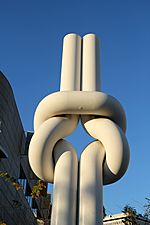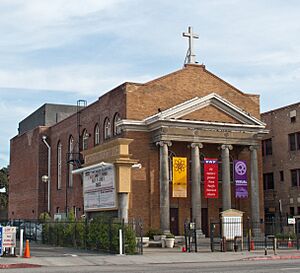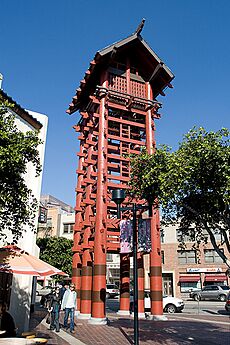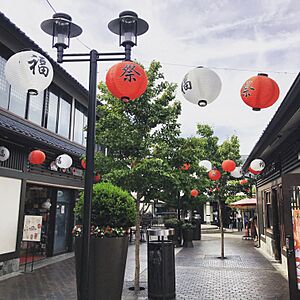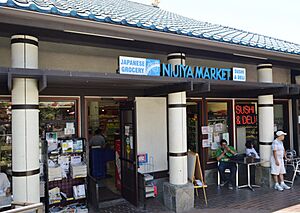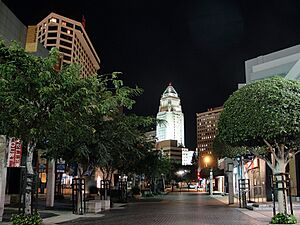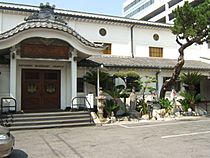Little Tokyo, Los Angeles facts for kids
|
Little Tokyo Historic District
|
|
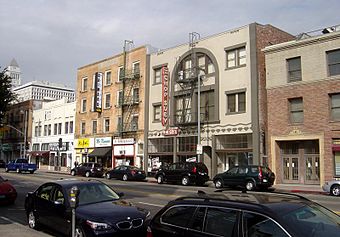
The Far East Café (Chop Suey), a landmark 1896 Beaux-Arts building
|
|
| Location | Los Angeles, California, U.S. |
|---|---|
| Built | 1942 |
| Architect | Edgar Cline, Et al. |
| NRHP reference No. | 86001479 |
Quick facts for kids Significant dates |
|
| Added to NRHP | August 22, 1986 |
| Designated NHLD | June 12, 1995 |
Little Tokyo (Japanese: リトル・トーキョー) is a special neighborhood in downtown Los Angeles. It is the main place for Japanese American culture in Southern California. It is also the largest of only three official Japantowns in the United States. The other two are in San Francisco and San Jose, California.
Little Tokyo started around the early 1900s. It is sometimes called Lil' Tokyo, J-Town, or Shō-Tōkyō (小東京). In 1995, it was named a National Historic Landmark District. This means it is a very important place in American history.
Contents
History of Little Tokyo
In 1905, Little Tokyo was a busy area. It had about 3,500 Japanese residents. Many Jewish, Russian, and American people also lived there. About 10,000 Japanese people in the city would visit this area often.
Little Tokyo attracted many Japanese immigrants. But in 1924, the Exclusion Act of 1924 stopped most new Japanese people from coming to the U.S. Shops lined First Street, and vegetable markets were on Central Avenue. Japanese Americans were very important in the vegetable business. This was because many successful Japanese American farms were in Southern California. By 1941, about 30,000 Japanese Americans lived in Little Tokyo.
During World War II, something sad happened. The U.S. government forced Japanese Americans to leave their homes. They were sent to special camps far away. This event is called the Japanese American internment. Because of this, Little Tokyo became empty.
For a short time, the area was called Bronzeville. Many African Americans, Native Americans, and Latinos moved into the empty homes and opened businesses. They came to Los Angeles to find jobs in factories that made things for the war. Rules called restrictive covenants stopped them from living in many other parts of the city. So, Bronzeville became very crowded.
In May and June 1943, there were attacks on Latino and some African American residents by white people. These were called the Zoot Suit Riots. After the war, many Japanese Americans returned. But there were not enough homes in Little Tokyo. So, many moved to nearby areas like Boyle Heights.
In the late 1970s, Little Tokyo began to change again. Japanese companies started to open offices in Los Angeles. New shopping centers and hotels were built. Even with these new buildings, some of the original shops and restaurants from old Little Tokyo are still there, especially on First Street.
Artists also started moving into old warehouses nearby. They created a hidden community. Places like Al's Bar and LA Contemporary Exhibitions (LACE) became well-known.
Little Tokyo is a special place because of its history. It is close to the Los Angeles Civic Center. It is also important for business between Japan and America. Even though not many Japanese residents live there now, it is still a strong community. This is because of the history of the Japanese American internment and efforts to get justice for it. Little Tokyo is a popular tourist spot, a community center, and home to many Japanese American seniors.
In 1959, Los Angeles became a "sister city" with Nagoya, Japan. This means they have a special friendship.
What Little Tokyo is Like Today
At its busiest, Little Tokyo had about 30,000 Japanese Americans living there. Today, it is still a main cultural spot for Japanese Americans in Los Angeles. It is mostly a place for work, culture, religion, restaurants, and shopping. Many Japanese Americans now live in cities like Torrance, Gardena, and Monterey Park. But new homes being built in downtown Los Angeles are bringing more people to Little Tokyo.
The original part of Little Tokyo is about five city blocks big. It is bordered by Los Angeles Street, Alameda Street, 3rd Street, and First Street. It also includes the area north of First Street. Here you can find the Japanese American National Museum, the Go for Broke Monument, and old shops. A timeline on the ground in front of these shops shows their history.
Fun Things to Do in Little Tokyo
Museums and Galleries
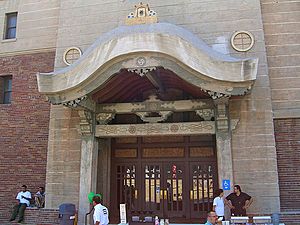
You can visit the Japanese American National Museum. There is also an extension of the Museum of Contemporary Art, called the Geffen Contemporary. LAArtcore is an art group that has many art shows each year. There is also an art gallery called 123 Astronaut. It is in a small kiosk on Astronaut Ellison Onizuka Street. This street has a monument to Astronaut Ellison S. Onizuka. He was a Japanese American from Hawaii who was on the Space Shuttle Challenger when it broke apart in 1986.
Public Art
Little Tokyo has many interesting public art pieces. One is a statue of Chiune Sugihara. He was a Japanese diplomat who helped many Jewish people escape during World War II.
Events
Every August, Little Tokyo hosts the Nisei Week festival. It has a big parade, a beauty pageant, sports events, Japanese art shows, and a taiko drum festival. There is also a street fair and a car show.
Gardens
You can visit two Japanese gardens in the area. One is the James Irvine garden at the Japanese American Cultural and Community Center. The other is a rooftop garden at the Kyoto Grand Hotel and Gardens. The Go for Broke Monument honors Japanese Americans who served in the U.S. Military during World War II.
Performing Arts
Little Tokyo is a hub for Asian American artists. The East West Players is one of the first Asian American theater companies in the country. They perform plays written and acted by Asian American artists. Their shows are at the David Henry Hwang Theater.
The Japanese American Community and Cultural Center (JACCC) has the Aratani Theater. It hosts plays, dances, concerts, and cultural events.
Visual Communications is an organization that supports Asian Pacific American media arts. They put on the VC FilmFest (Los Angeles Asian Pacific Film Festival) each year.
Tuesday Night Project is a long-running open mic event for Asian American artists. It happens twice a month from April to October. Cold Tofu Improv was the first Asian American improv comedy group. Kollaboration helps Asian, Pacific Islander, and Desi Americans (APIDA) in music and entertainment.
Many famous actors, musicians, and entertainers started their careers here. Some examples are Daniel Dae Kim, John Cho, Lucy Liu, and George Takei.
Shopping and Dining
Little Tokyo has many Japanese restaurants. They offer different kinds of Japanese food. You can find places that specialize in donburi (rice bowls), Japanese noodles like soba, ramen, and udon. There's also shabu-shabu, where you cook meat and veggies in boiling water. You can also find Japanese curry, sushi, and yakitori (grilled skewers). Some restaurants have yakiniku, where you cook meat on a grill at your table. The famous California roll was invented here by a chef named Ichiro Mashita.
Two very old Japanese sweets shops are in Little Tokyo. Fugetsu-do, started in 1903, makes mochi and manjū. They even say they invented the fortune cookie! Mikawaya, founded in 1910, is famous for bringing mochi ice cream to the U.S. in 1994.
You can also find shops selling Japanese-language videos and DVDs. Other stores have Japanese electronics and video games. These are great for finding games that were not released in English. There are also many shops that sell manga and anime products.
Japanese Village Plaza
The Japanese Village Plaza is in the middle of Little Tokyo. It has many restaurants and shops for tourists. First Street and Second Street are next to the plaza and have more restaurants that stay open later.
Weller Court
The Weller Court shopping mall is on Astronaut Ellison S Onizuka Street. It has restaurants, karaoke clubs, and a Bubble Tea cafe. For visitors from Japan, there are shops with expensive brand-name products. There is also a large bookstore called Kinokuniya. It is a famous Japanese chain. They have many Japanese books, magazines, music CDs, manga, and anime. They also have English books about Japan and translated manga and anime.
Weller Court was built in the late 1970s. Before that, the area had many small, family-owned businesses.
Education in Little Tokyo
The Los Angeles Unified School District serves the area.
- 9th Street Elementary School
- Hollenbeck Middle School
- Belmont High School
The Los Angeles Public Library has a Little Tokyo Branch. There was also a part-time Japanese school, Asahi Gakuen, located here. It has since moved to another area.
Religion in Little Tokyo
There are several Buddhist temples in Little Tokyo. These include Jodo Shinshu, Jodo Shu, Shingon, and Soto Zen temples. Zenshuji was the first Soto Zen temple in North America. Koyasan Buddhist Temple was the first Shingon temple in North America. There are also a few Japanese Christian churches.
An important religious movement called the Azusa Street Revival started in Little Tokyo in 1906. It began at the First Pentecostal Church, which was a church for people of different races.
St. Francis Xavier Chapel is the center for the Japanese Catholic community. It started in 1912. Masses are offered in Japanese and English every Sunday.
The old Cathedral of Saint Vibiana is just west of Little Tokyo. After an earthquake in 1994, the church moved. The old building was turned into a performing arts space. A new Little Tokyo Branch of the Los Angeles Public Library was built there too.
Getting Around Little Tokyo
You can get to Little Tokyo using the Metro A Line and Metro E Line at the Little Tokyo/Arts District station. You can also walk from the Metro B and D subway lines. These connect to other train and bus services. The Little Tokyo/Arts District station was moved underground and reopened in June 2023.
Metro Local bus lines 30 and 330 also serve Little Tokyo.
Little Tokyo in Movies and TV
Little Tokyo has been featured in several films. These include Showdown in Little Tokyo, Beverly Hills Ninja, and The Crimson Kimono. In the Japanese anime series Kyatto Ninden Teyandee (キャッ党忍伝てやんでえ), which was called Samurai Pizza Cats in English, the main city was renamed "Little Tokyo."
|




